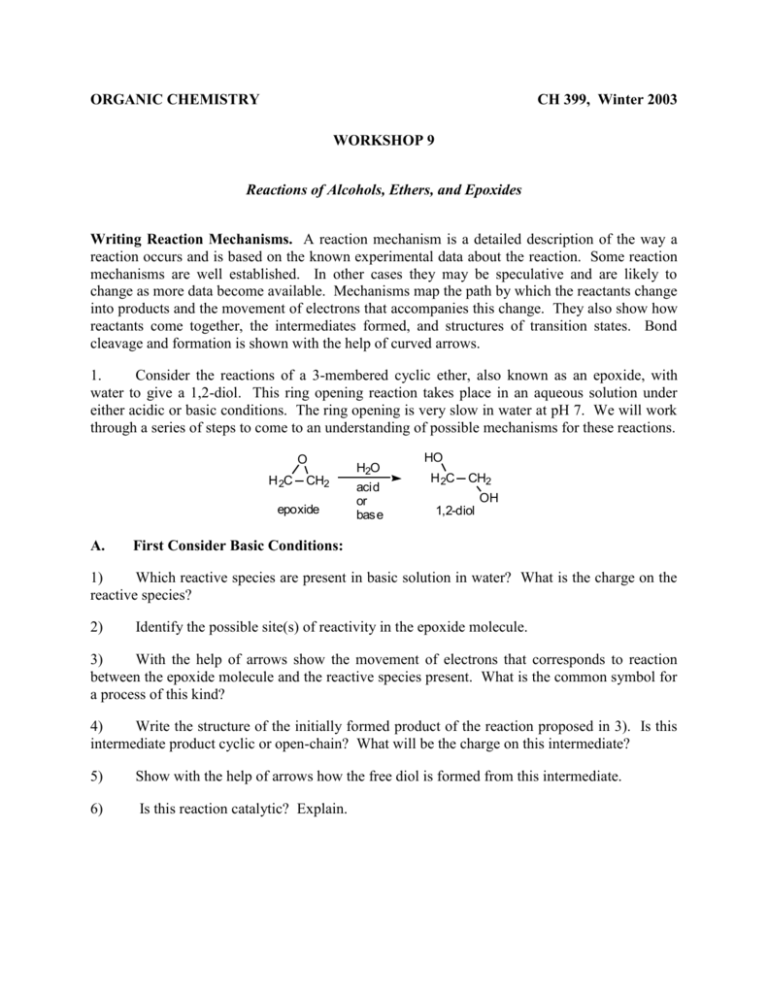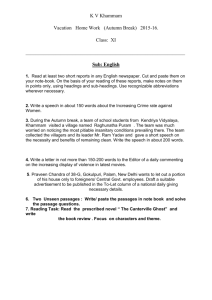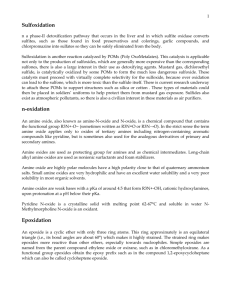ORGANIC CHEMISTRY
advertisement

ORGANIC CHEMISTRY CH 399, Winter 2003 WORKSHOP 9 Reactions of Alcohols, Ethers, and Epoxides Writing Reaction Mechanisms. A reaction mechanism is a detailed description of the way a reaction occurs and is based on the known experimental data about the reaction. Some reaction mechanisms are well established. In other cases they may be speculative and are likely to change as more data become available. Mechanisms map the path by which the reactants change into products and the movement of electrons that accompanies this change. They also show how reactants come together, the intermediates formed, and structures of transition states. Bond cleavage and formation is shown with the help of curved arrows. 1. Consider the reactions of a 3-membered cyclic ether, also known as an epoxide, with water to give a 1,2-diol. This ring opening reaction takes place in an aqueous solution under either acidic or basic conditions. The ring opening is very slow in water at pH 7. We will work through a series of steps to come to an understanding of possible mechanisms for these reactions. O H 2C CH2 epoxide A. H2O acid or base HO H 2C CH2 OH 1,2-diol First Consider Basic Conditions: 1) Which reactive species are present in basic solution in water? What is the charge on the reactive species? 2) Identify the possible site(s) of reactivity in the epoxide molecule. 3) With the help of arrows show the movement of electrons that corresponds to reaction between the epoxide molecule and the reactive species present. What is the common symbol for a process of this kind? 4) Write the structure of the initially formed product of the reaction proposed in 3). Is this intermediate product cyclic or open-chain? What will be the charge on this intermediate? 5) Show with the help of arrows how the free diol is formed from this intermediate. 6) Is this reaction catalytic? Explain. B. Now Consider Acidic Conditions: 1) Which reactive species are present in an acidic solution in water? What is the charge on the reactive species? 2) Identify the possible site(s) of reactivity in the epoxide molecule. 3) With the help of arrows show the movement of electrons that corresponds to reaction between the epoxide molecule and the reactive species present. 4) Write the structure of the initially formed product of the reaction proposed in 3). Is this intermediate product cyclic or open chain? What will be the charge on this intermediate? 5) Identify the possible site(s) of reactivity in this intermediate. Identify a species in solution that would react with this intermediate. Show with the help of arrows how the intermediate reacts with a species in solution. (Remember that the net reaction involves ring opening.) 6) Write the structure of the initially formed product of the reaction proposed in 5). What is the charge on this first-formed product? Show with the help of arrows how the free diol is formed from this initially formed product. 7) Is this reaction catalytic? Explain. 2. Propose a reasonable mechanism for the reaction below, in which compound A is transformed to compound B by reaction with base. Use the arrow formalism to show the flow of electrons. Br H O H CH3 O K H A O CH3 OH B O 3. Peroxycarboxylic acids (RCO3H) react with alkenes to give three-membered ring cyclic ethers (epoxides). For example, 3-hexene reacts with peroxyacids to give 3,4-epoxyhexane. CH3 CH2CH=CHCH 2CH2CH 3 RCO3H CH 3CH2 CH CHCH2CH 3 O 3,4-epoxyhexane a. When the reaction is performed on cis-3-hexene, the 3,4-epoxyhexane that is formed cannot be separated into optically active molecules. i. What is the structure of the 3,4-epoxyhexane formed from cis-3-hexene? ii. What is the stereochemical mode of the addition of the oxygen to the double bond? i.e., Are the bonds to the oxygen formed syn or anti with respect to the double bond? b. The 3,4-epoxyhexane from cis-3-hexene reacts with H2O in the presence of an acid catalyst. The epoxide ring is opened to give 3,4-hexanediol. This 3,4-hexanediol can be separated into optically active forms. O CH 3CH2 CH OH OH CHCH2CH 3 from cis-3-hexene i. H3O cat H2O CH 3CH2 CH CHCH2CH 3 3,4-dihydroxyhexane What is the stereochemistry of the 3,4-hexanediol formed from cis-3-hexene? 4. The following sets of starting materials failed to give the target molecules when used in the Williamson synthesis of ethers. Explain why they didn’t work, and propose a better way to accomplish the desired transformations. H i. CH2 OH + C O Br target H CH3 CH3 ii. CH3 CH2OH + H 3C C Br CH3 CH3 CH2O C CH3 CH3 target








